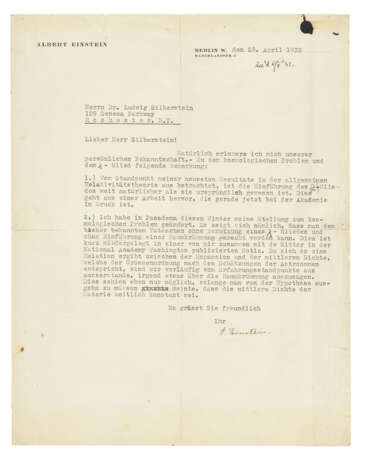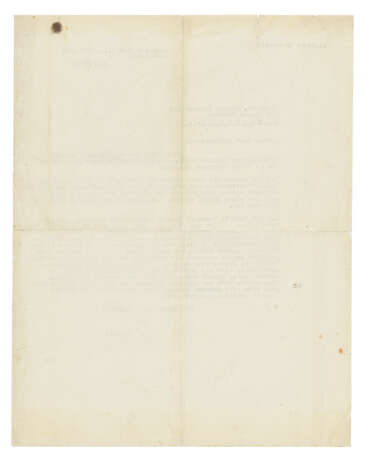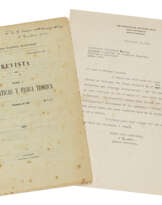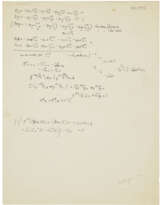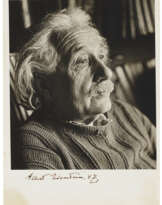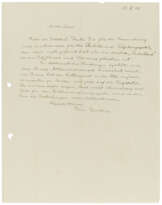ID 1449866
Lot 40 | Albert Einstein (1879-1955)
Valeur estimée
£ 25 000 – 30 000
Typed letter signed ('A. Einstein') to Dr Ludwig [i.e. Ludwik] Silberstein, Haberlandstrasse 5, Berlin, 23 April 1932
In German. One page, 282 x 223mm, the term 'λ' inserted three times in manuscript, on paper with Einstein's printed heading, annotated with date of receipt.
Einstein and the expanding universe: 'This winter in Pasadena, I changed my position on the cosmological problem' –a significant letter on one of Einstein's most important and controversial propositions, the cosmological constant, λ.
Einstein had introduced the term λ in 1917 as a modification to the general theory of relativity born from his discomfort with the fact that his field equations did not allow for a static universe. Einstein himself is reported (by Gamow and others) to have called the 1917 formulation of the cosmological constant “the biggest blunder of my life,” and he frequently expressed a dislike for it (saying 'I am unable to believe that such an ugly thing is actually realised in nature') and when observations by Edwin Hubble in 1929 showed that the universe was expanding, Einstein came to believe that he had been wrong, and in his 1932 paper with Willem de Sitter (referred to here) he proposed a model of a continuously expanding universe with a zero cosmological constant (known as Einstein-de Sitter spacetime).
Here, he writes to Silberstein to report this recent change of mind:
'1. From the standpoint of my recent results in general relativity, the introduction of the λ term is far more natural than it originally seemed. This is evident from a paper currently in print at the Academy.
2. This winter in Pasadena, I changed my position on the cosmological problem. It turns out that one can account for the previously known facts without using a λ term and without introducing a curvature of space. This is briefly demonstrated in a note published by me together with de Sitter at the National Academy in Washington. Since such a relationship arises between expansion and mean density, which corresponds in magnitude to the estimates of astronomers, we are, for the time being, empirically unable to say anything about the curvature of space. This only seemed possible as long as one had to start from the hypothesis that the mean density of matter is constant over time'.
The cosmological constant remains a major subject of contention, even today when it is once again in the foreground of scientific discussion, now closely associated with the concept of dark energy. Though Einstein here appears to maintain an indecisive attitude towards the λ term, describing it as both 'more natural' than previously thought but also no longer necessary to account for observed facts, recent consensus amongst physicists, especially since the discovery in 1998 that the expansion of the universe is accelerating, has been that the cosmological constant does indeed have a positive value.
The Polish-American physicist Ludwik Silberstein (1872-1948) was an early interpreter of the special theory of relativity: his lectures on the subject at University College London in 1912/13 were adapted and published as the textbook The Theory of Relativity (1914). His later relations with Einstein were somewhat more fraught: he published a gravitational theory in 1918 attempting unsuccessfully to supplant the general theory of relativity, and in 1935 he had a public disagreement with Einstein over his claims (subsequently discredited) to have discovered a flaw in the general theory.
| Artiste: | Albert Einstein (1879 - 1955) |
|---|---|
| Lieu d'origine: | Europe de l'Ouest, Allemagne, Europe, Suisse |
| Catégorie maison de vente aux enchères: | Lettres, documents et manuscrits, Médecine et sciences, Livres et manuscrits |
| Artiste: | Albert Einstein (1879 - 1955) |
|---|---|
| Lieu d'origine: | Europe de l'Ouest, Allemagne, Europe, Suisse |
| Catégorie maison de vente aux enchères: | Lettres, documents et manuscrits, Médecine et sciences, Livres et manuscrits |
| Adresse de l'enchère |
CHRISTIE'S 8 King Street, St. James's SW1Y 6QT London Royaume-Uni | |
|---|---|---|
| Aperçu |
| |
| Téléphone | +44 (0)20 7839 9060 | |
| Commission | see on Website | |
| Conditions d'utilisation | Conditions d'utilisation |
